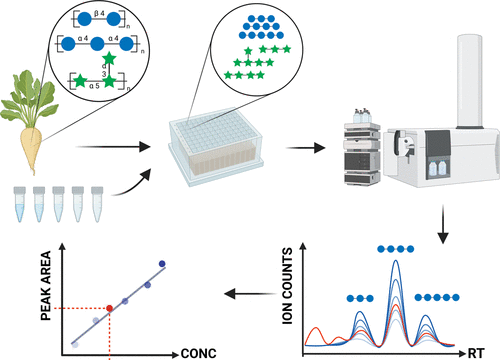Quantitative Glycomics Service
Glycans play a key role in various biological processes such as cell recognition, signal transduction, and immune regulation. Glycomics research helps to reveal the functions of glycosylation modifications in life activities. Through quantitative analysis, it is possible to accurately capture the changes in glycans, providing a panoramic view of the glycosylation status, which is crucial for understanding biological processes and functions. Quantitative glycomics analysis aims to quantify the composition, structure, and abundance of glycans in samples using various quantitative strategies.
Quantitative glycomics service is widely applied in various fields, particularly in food science, plant research, and agriculture. In the food industry, it can be used for the quantitative analysis of carbohydrate components to ensure product quality and standardization; in plant and agricultural research, it helps reveal the role of glycosylation modifications in plant growth and stress resistance; in environmental monitoring, it analyzes carbohydrate components in environmental samples, advancing ecological and environmental research.

Bacalzo, N P. et al. Analytical Chemistry, 2022.
Figure 1. Overview of the Analytical Method for the Identification and Quantitation of Polysaccharides.
Services at MtoZ Biolabs
Based on advanced analytical and technological platforms, the quantitative glycomics service launched by MtoZ Biolabs enables high-precision quantitative analysis of glycans in biological samples. Through optimized analytical methods, this service can provide a detailed characterization of the composition, structure, distribution, and abundance of glycans in samples. The quantitative data we provide include the relative abundance of glycans, types of modifications, and distribution characteristics across different samples. These data can support glycosylation research, glycoantigen development, food quality control, and consistency assessment of biopharmaceutical products.
Analysis Workflow
1. Sample preparation
(1) Glycan extraction
Glycans are released from the sample through enzymatic or chemical methods, and specific enrichment techniques are used to extract the target glycans.
(2) Derivatization
Derivatization is performed as needed to improve glycan detectability and analytical sensitivity, ensuring accurate analytical results.
2. Separation
(1) Capillary electrophoresis
Capillary electrophoresis (CE) is used to separate glycans, reducing co-elution interference and ensuring efficient separation of individual glycan components.
(2) Liquid chromatography separation
High-performance liquid chromatography (HPLC) is applied to further refine glycan separation, enhancing separation efficiency and analytical precision.
3. Mass spectrometry analysis
High-resolution mass spectrometry (MS) is used to perform qualitative and quantitative analysis of the separated glycans, accurately identifying glycan types, structural features, and abundances.
4. Data analysis and report generation
Bioinformatics methods are applied to process and interpret the data, generating detailed reports that provide quantitative data, structural characteristics, and distribution information of glycans.
Sample Submission Suggestions
1. Sample types
Applicable to various biological samples containing glycan components, including glycoproteins, cell culture supernatants, tissue lysates, serum, plasma, and others. Samples can be in liquid or solid form, and the integrity of the glycans must be maintained.
2. Sample purity
It is recommended to remove impurities as much as possible to reduce interference and improve analytical accuracy. For complex samples, preliminary impurity removal is advised to ensure the accuracy of the analysis.
3. Sample storage and transportation
Samples should be transported at low temperatures. Liquid samples can be shipped with ice packs or dry ice, while solid samples should be sealed and protected from moisture. To ensure sample quality, it is recommended to keep them frozen or chilled during transportation.
Service Advantages
1. High-precision analysis
Utilizing high-resolution liquid chromatography (HPLC) and mass spectrometry (MS) technologies, we provide high-precision quantitative glycan analysis to ensure the accuracy and reliability of results.
2. High-sensitivity detection
Capable of detecting low-abundance glycan components, suitable for the analysis of complex biological samples, ensuring sensitive and accurate quantitative data.
3. Customized analytical solutions
Tailoring analytical strategies based on the client’s research objectives and sample characteristics, flexibly meeting diverse research needs and ensuring that the analytical plan aligns with specific requirements.
4. One-stop service
Offering end-to-end solutions from sample preparation, glycan extraction, and analytical detection to data interpretation, simplifying experimental procedures and improving research efficiency.
Applications
1. Glycomics research
The quantitative glycomics service can be used to analyze the composition and abundance of glycans in various biological samples, helping to reveal the role of glycosylation in biological processes such as cell function and signal transduction, and advancing in-depth glycomics research.
2. Biopharmaceutical quality control
This service can monitor the composition and stability of glycans in biopharmaceutical products such as glycoproteins and glycolipids during production, ensuring product quality consistency and stability.
3. Food and nutrition research
The quantitative glycomics service can be applied to analyze carbohydrate components in food, ensuring formulation standardization and quality control, and playing an important role in the development of functional foods and nutritional products.
4. Environmental and agricultural research
By analyzing the glycan composition in plant samples, this service helps to reveal the role of glycosylation modifications in plant growth, development, and stress resistance, thereby promoting agricultural research and crop improvement.
Deliverables
1. Comprehensive Experimental Details
2. Materials, Instruments, and Methods
3. Data Analysis, Preprocessing, and Estimation
4. Bioinformatics Analysis
5. Raw Data Files
Related Services
Glycan Separation and Purification Services
How to order?







